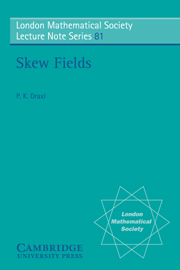Part III - Reduced K1-Theory of Skew Fields
Published online by Cambridge University Press: 04 August 2010
Summary
The history of reduced K1-Theory begins with Y. Matsushima & T. Nakayama [1943] who proved (in modern notation) for a K-skew field D
(1) SK1(D) = {1} in case K is a p-adic field.
Later Wang Shianghaw [1950] established a proof of
(2) SK1(D) = {1} in case K is an algebraic number field.
In his proof he used the Grunwald Theorem (on the existence of cyclic number field extensions with prescribed local behaviour) from Class Field Theory. On this occasion, incidentally, Wang Shianghaw discovered the (famous) gap in Grunwald's original proof and suggested a new version of the above mentioned theorem which is nowadays called the Grunwald–Wang Theorem (see e.g. E. Artin & J. Tate [1968]).
It was because of the results (1) and (2) that
(3) SK1(D) = {1}
was widely believed to hold in general.
Finally V.P. Platonov (cf. В.П. Платонов [1975]) proved that (3) is false in general! In §24. we explain this by introducing an ad hoc counter example (which, in order to be understood, requires hardly more knowledge of skew fields than contained in §1. of these lectures). Before this, however, we develop a theory of (the functorial properties of) K1 and SK1 over a skew field (see §22/23.) which includes proofs of the algebraic part of the classical results (1) and (2) (some number theoretic facts needed for the proof can only be stated without proof, for otherwise we would have to go far beyond the scope of these lectures).
- Type
- Chapter
- Information
- Skew Fields , pp. 125 - 126Publisher: Cambridge University PressPrint publication year: 1983



